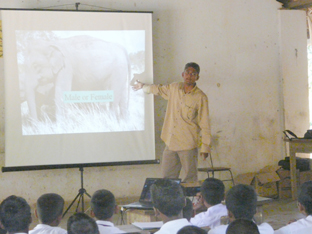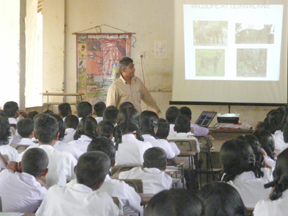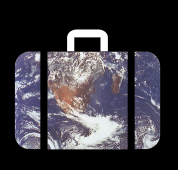Field work - - -
Together with my local counterparts, I have created an identification catalogue of around 300 females. We have recently begun to work on males, and have already counted up to 100. This is quite a bit higher than the population that was expected to live in this relatively small reserve, generating a lot of local curiosity and interest in our work.
We audio- and video- record calls whenever they occur, including infrasonic sounds. But elephants produce many different sounds, some of which are difficult to believe as originating from elephants. A description of all the different types of calls we've come accross, and their apparent functions will be coming out in Behaviour, summer of 2010. Some of these calls have never been described before. We then tie together the descriptions of social organization and vocal communication to understand how vocal communication helps to maintain social ties among individuals. One of my long-term goals is to maintain demography at this site. We have begun to record births, growth, and deaths. No continuous dataset like this exists for Asian elephants so far.
---------------------------------------------------------------------------------------------------------- Hear and see an audio slideshow of our work: http://www.sas.upenn.edu/home/SASFrontiers ----------------------------------------------------------------------------------------------------------
- - - Other work
Mappermaker - A collaboration with Ted Wong, Assistant Professor, at the Department of Biology in Bryn Mawr College to bring free, language-customized portable GIS to your pen-drive. Allows you to transform a QGIS platform into the language of your choice and share or search for language sets uploaded by other users. Take it with you to remote areas, use it as a teaching tool for non-English speakers. Make basic (yet powerful) GIS technology accessible to your target group. www.mappermaker.org
|

 Data is gathered by spending the whole day (10-12 hours!) in the field, usually driving or looking for shade near a grazing, bathing, playing, or sleeping group of elephants. We do this several times a week, and have been monitoring continuously since June 2006. We mark locations of all sightings via GPS and try to follow animals we recognize for as long as they stay visible.
Data is gathered by spending the whole day (10-12 hours!) in the field, usually driving or looking for shade near a grazing, bathing, playing, or sleeping group of elephants. We do this several times a week, and have been monitoring continuously since June 2006. We mark locations of all sightings via GPS and try to follow animals we recognize for as long as they stay visible.

 Ashoka, speaking at a school in Uda Walawe.
Ashoka, speaking at a school in Uda Walawe.

 I am collaborating with Sharon S. Glaeser from Portland State University to compare my recordings of wild elephants to those of captive ones at the Oregon Zoo. We have found apparent repertoire disparities among the two demographics. These comparisons could help zoos enrich the lives of their charges, while shedding light on the functions of these calls among their wild relatives.
I am collaborating with Sharon S. Glaeser from Portland State University to compare my recordings of wild elephants to those of captive ones at the Oregon Zoo. We have found apparent repertoire disparities among the two demographics. These comparisons could help zoos enrich the lives of their charges, while shedding light on the functions of these calls among their wild relatives.
